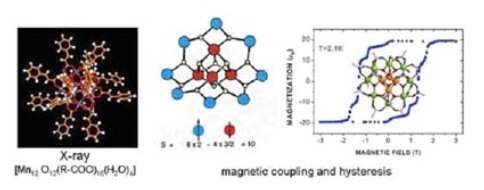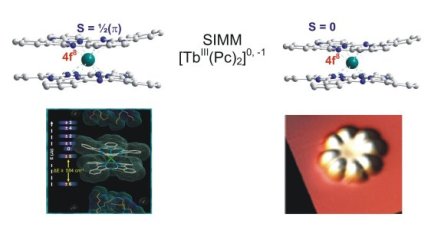Single Molecule Magnets (SMM)
An exciting development in nanoscale magnetic materials occurred in 1993 when [Mn12O12 (O2CMe)16(H2O)4] (hereafter Mn12) was identified as nanoscale magnet, the first to comprise discrete, magnetically non-interacting molecular units rather than a 3D extended lattice (as in metals and metal oxides, for example). The discovery initiated the field of molecular nanomagnetism and such molecules have since been termed single-molecule magnets (SMMs). They derive their special magnetic properties from the combination of a large spin (S) and an Ising (easy-axis) magneto-anisotropy exhibiting a negative zero-field splitting parameter (D), which gives rise to the superparamagnetic-like property of a barrier to magnetization relaxation. This class of compounds does not only display magnetisation hysteresis, but also quantum tunnelling of magnetisation (QTM) and quantum phase interference.

Molecular structure (left), magnetic coupling scheme and hysteresis (right) of the Mn12 family
exhibiting magnetic hysteresis and quantum tunnelling of magnetization (QTM)
Single-Ion Molecule Magnets (SIMMs)
A class of molecules emerged recently where slow relaxation of the magnetic moment arises from a single f-metal ion coordinated by two phthalocyaninato rings (Pc2Ln). These compounds were first described by N. Ishikawa et al. and are formulated in literature as Single-Ion Molecule Magnets (SIMMs); hence they exhibit slow magnetization relaxation as single-molecular property, hysteretic behaviours at low temperatures, and resonant quantum tunnelling of magnetization between hyperfine levels. The high temperature activated spin dynamics of the SIMM [Pc2Tb]-[TBA]+ was determined by solid state 1H NMR spectroscopy showing the implication of phonon-assisted transitions among the crystal field levels with unprecedented activation barriers ranging from 641 cm-1 for the diamagnetically diluted to 584 cm-1 for undiluted samples. Furthermore, the SIMM [Pc2Tb]0 was deposited onto Cu(111) approaching the realisation of single molecular data storage.

Molecular structure (top) of two variations of a SIMM, [TbPc2]- and [TbPc2]0, showing (left) the effective energy barrier Δ for the magnetic moment reversal determined by the ligand field potential (CF) around the f-metal and (right) an STM image of a single SIMM on a Cu(111) surface

